
Did you ever feel pressured to provide unrealistic targets or underestimate forecasts? If terms like “sandbagging” leave you puzzled, you’re not alone. This slippery business practice flies under the radar more than you’d think. So, what does sandbagging mean?
Sandbagging is purposely underestimating key performance targets or future forecasts for a business. It involves setting lower expectations than you actually plan on being able to achieve. The idea is to make sure you can deliver on those conservative estimates.
We’ll discuss why many managers end up sandbagging, even subconsciously. We’ll also talk about potential impacts, both positive and negative. Our goal is to provide an insider’s lens so you can evaluate if sandbagging is happening in your organization.
Sandbagging Meaning Origin
The origin of ‘sandbagging’ dates back to the 1580s, from the term ‘sandbag,’ a bag filled with sand used as a weapon.
By the 1880s, ‘sandbagging’ referred to ambushing someone from behind a sandbag barrier. In the 1940s, it took on a new meaning: waiting for someone else to act first, hoping they’ll make a bigger move or decision.
Today, sandbagging is often used in a business context. It means a person or company is hiding the true situation to mislead others, usually for some strategic advantage.
What is Sandbagging in Sales?
Sandbagging in sales is when a salesperson doesn’t immediately report all their deals. They do this to set lower expectations with their managers. Later, they reveal these deals to look like they are doing better than expected.
A sales team’s main goal is to turn potential customers into actual buyers. They’re trained to pursue leads and are evaluated based on meeting monthly sales targets, reviewed every quarter. Sandbagging becomes a strategy for sales representatives to create an advantage for themselves.
What Does Sandbagging Mean in Business?
In the corporate world, sandbagging in business means intentionally setting low expectations. This way, when the actual results come in, they appear more impressive than they really are.
This tactic makes companies or individuals look like high achievers. However, they might just be performing at an average level without showing their full potential. Often, management, investors, or other key players are unaware of this strategy.
Does Sandbagging Work?
Yes, it does. Sandbagging, especially in a sales context, involves a strategic approach to managing expectations and dealing with uncertainty. Here are some steps and considerations for effectively implementing sandbagging:
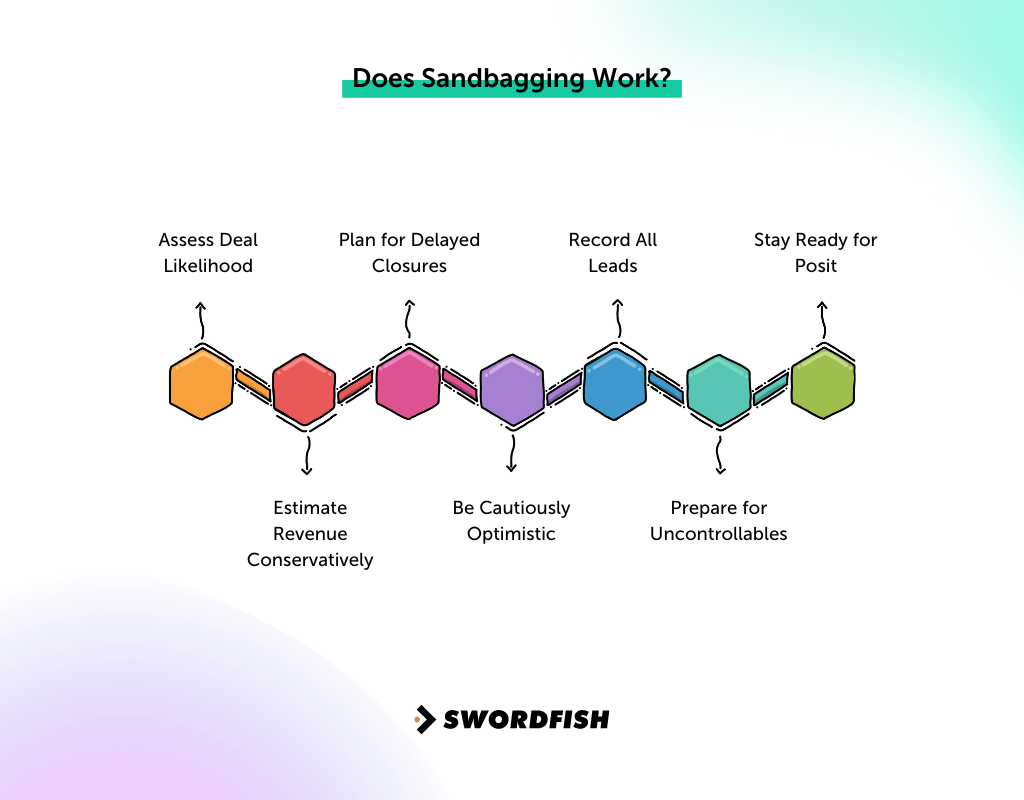
Assess Deal Likelihood
Evaluate how likely each deal is to close. Be realistic, or even slightly pessimistic, about the chances of each sale. If a deal has a 70% chance of closing, you might record it as having a 50% chance in your forecasts.
Estimate Revenue Conservatively
For deals with a variable revenue outcome, such as contracts that could be worth anywhere between $15,000 and $30,000, always forecast using the lower end of the range. In the example you provided, you would forecast $15,000 instead of the potential $30,000.
Plan for Delayed Closures
Even if a deal is likely to close this month, consider predicting that it will close in the following month. This accounts for unexpected delays, which are common in business transactions.
Be Cautiously Optimistic
While sales managers are typically optimistic, sandbagging requires a more conservative approach. It’s about erring on the side of caution and underestimating rather than overestimating your sales performance.
Record All Leads
Continue to enter all prospective leads into your Customer Relationship Management (CRM) system but adjust their likelihood of closing.
For instance, if you’re usually 80% confident in a lead, you might record it as 60% in a sandbagging approach.
Prepare for Uncontrollables
Acknowledge that many factors in sales are beyond your control – emails may not reach the intended recipient, clients might get preoccupied with other vendors, or customers might opt for a cheaper option.
Sandbagging helps in managing these uncertainties by setting expectations that account for such eventualities.
Stay Ready for Posit
Stay Ready for Positive Surprises: By expecting less, you position yourself to be pleasantly surprised when things go better than anticipated. This can also lead to a more positive perception of your performance from higher-ups or stakeholders.
How Does Sandbagging Work?
Based on the definition of sandbagging in business, it typically works by intentionally setting lower expectations than what is realistically achievable. This strategy can be implemented in various aspects of business operations and has several key components:
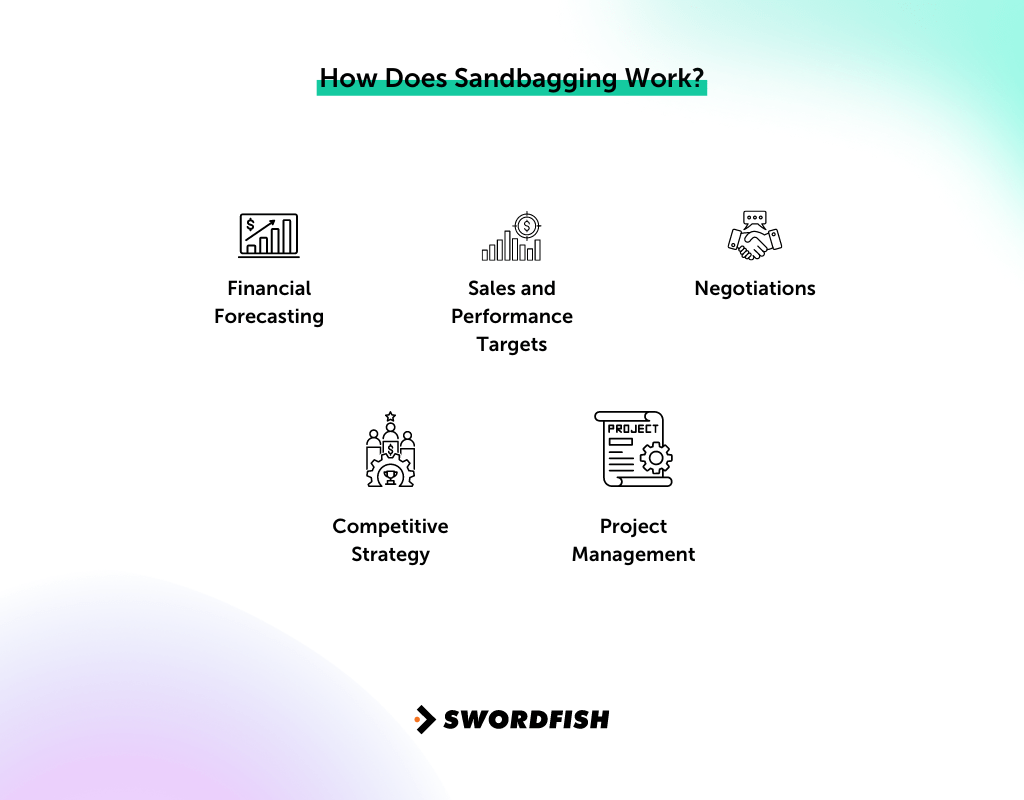
Financial Forecasting
Companies often provide guidance or forecasts about their expected financial performance, such as revenue, profits, or growth metrics. In sandbagging, a company might deliberately issue conservative or lower-than-actual expected forecasts.
When the actual results are announced, if they exceed these conservative estimates, the company appears to have performed exceptionally well, often leading to positive reactions from investors and analysts.
Sales and Performance Targets
In a sales context, a salesperson might practice sandbagging by underestimating the sales they expect to close in a given period.
By setting lower targets, they can easily exceed them, making their performance appear outstanding. This can lead to recognition, bonuses, or promotions.
Negotiations
During business negotiations, such as mergers, acquisitions, or partnerships, a company might undervalue its assets, capabilities, or potential. This can be a tactic to secure better terms, gain leverage in negotiations, or manage the expectations of the other party.
Competitive Strategy
Businesses might also use sandbagging as a competitive strategy. By understating their capabilities or market strategies, they can mislead competitors.
This could lead to competitors underestimating them, allowing the sandbagging company to gain market share or launch new products without significant opposition.
Project Management
In project management, a manager might give longer timelines or lower expectations of project outcomes.
This can provide a buffer for unforeseen circumstances and makes it more likely that the team will complete the project ahead of schedule or exceed expectations, leading to a perception of efficiency and effectiveness.
Why Does Sandbagging Happen in Business?
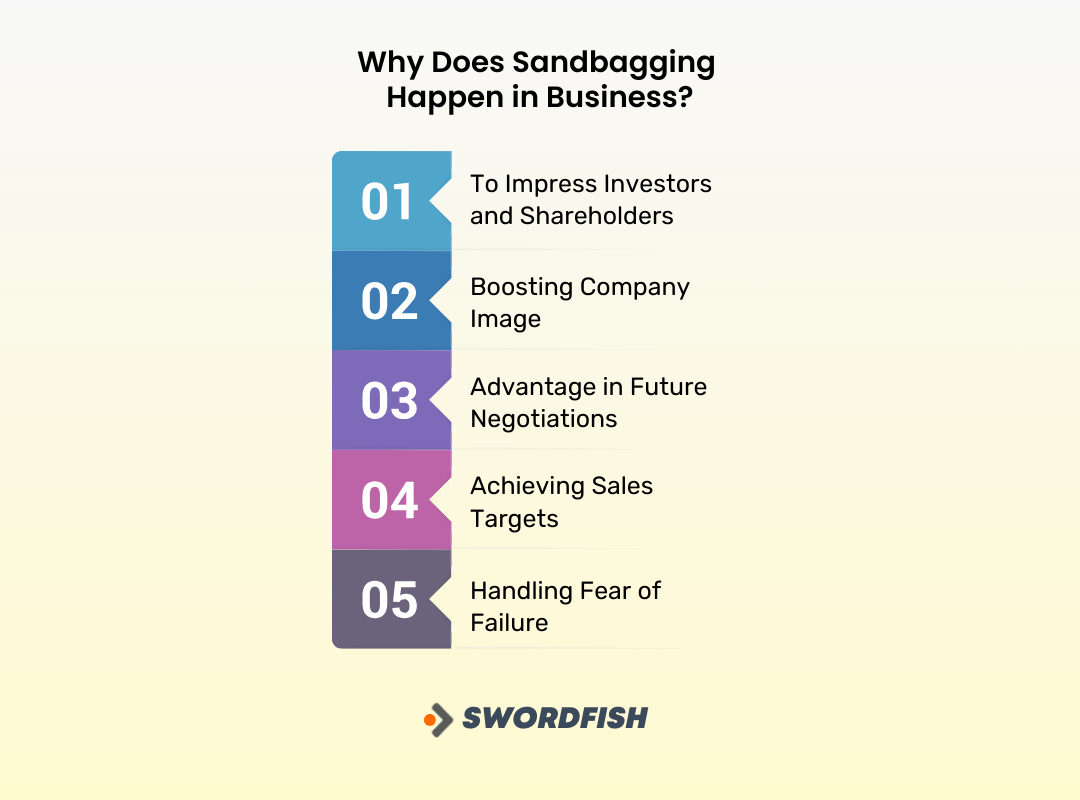
Sandbagging business terms in the business world is quite common because it’s easier to exceed low expectations. Everyone likes to be seen as the person who defies the odds, right?
But there are a few specific reasons why businesses engage in this practice.
1. To Impress Investors and Shareholders
Business leaders might intentionally forecast lower profits or downplay growth indicators. This sets modest expectations for investors and shareholders. It’s a pleasant surprise for shareholders and investors when the company performs better than expected.
It can strengthen their interest and trust in the business.
2. Boosting Company Image
A company might use it to enhance its public reputation. For instance, a company might publicly predict lower growth for the next quarter than what they actually expect.
When the quarter ends with better results, it creates a buzz. This unexpected success can attract media attention, increase the company’s popularity, and improve its public image.
3. Advantage in Future Negotiations
In the business world, especially among startups, under promising and over delivering can be a strategic move. Startups, where investor trust is vital and future success is hard to predict, often use this tactic.
Showing a track record of surpassing expectations can be a strong point in future negotiations. While under promising and over delivering can be beneficial, incorporating the best sales prospecting techniques is also crucial for long-term success.
4. Achieving Sales Targets
In 2020, 40% of companies didn’t hit their sales goals. Sales teams might do sandbagging to ensure they hit their targets. By predicting lower sales numbers, they’re more likely to achieve them.
Plus, if a company offers bonuses for meeting sales goals, underestimating and then exceeding these goals can lead to higher bonuses or commissions.
5. Handling Fear of Failure
Sandbagging isn’t just about personal gain. Sometimes, professionals use this strategy to cope with a deep fear of failure. They might feel that too much attention, even when it’s positive, brings unnecessary stress and pressure.
In these situations, setting lower expectations acts as a safeguard, easing the pressure they feel from themselves and others. Professionals coping with the fear of failure can also benefit from learning how to perform sales data analysis.
It helps in setting realistic goals and expectations
Advantages of Sandbagging
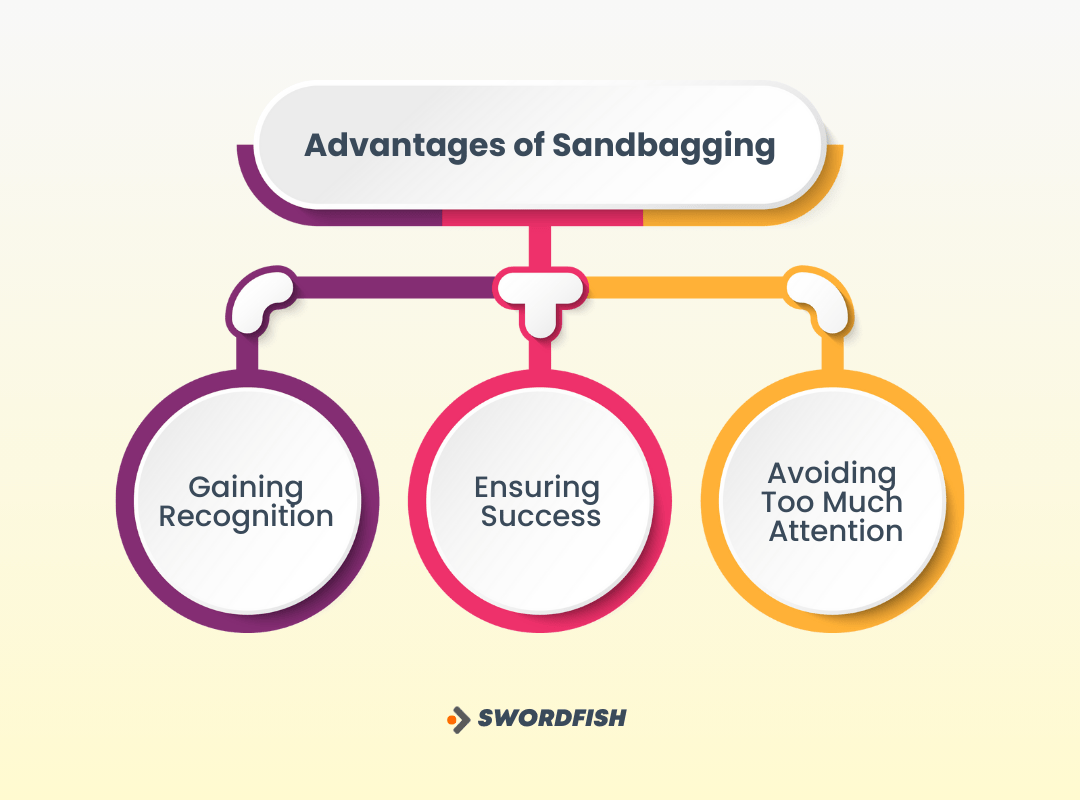
While often seen as unethical, sandbagging can seem beneficial in certain work situations. These include:
- Gaining Recognition: By exceeding low expectations, you might impress your boss. This could lead to a raise, bonus, or promotion.
- Ensuring Success: If you’re unsure about a task, project, or sale, sandbagging gives you more time before reporting results.
- Avoiding Too Much Attention: Playing down your work can mean less oversight from managers or colleagues.
However, it’s crucial to remember that these benefits are usually temporary. Plus, sandbagging someone can damage trust and team dynamics in the long run.
Disadvantages of Sandbagging
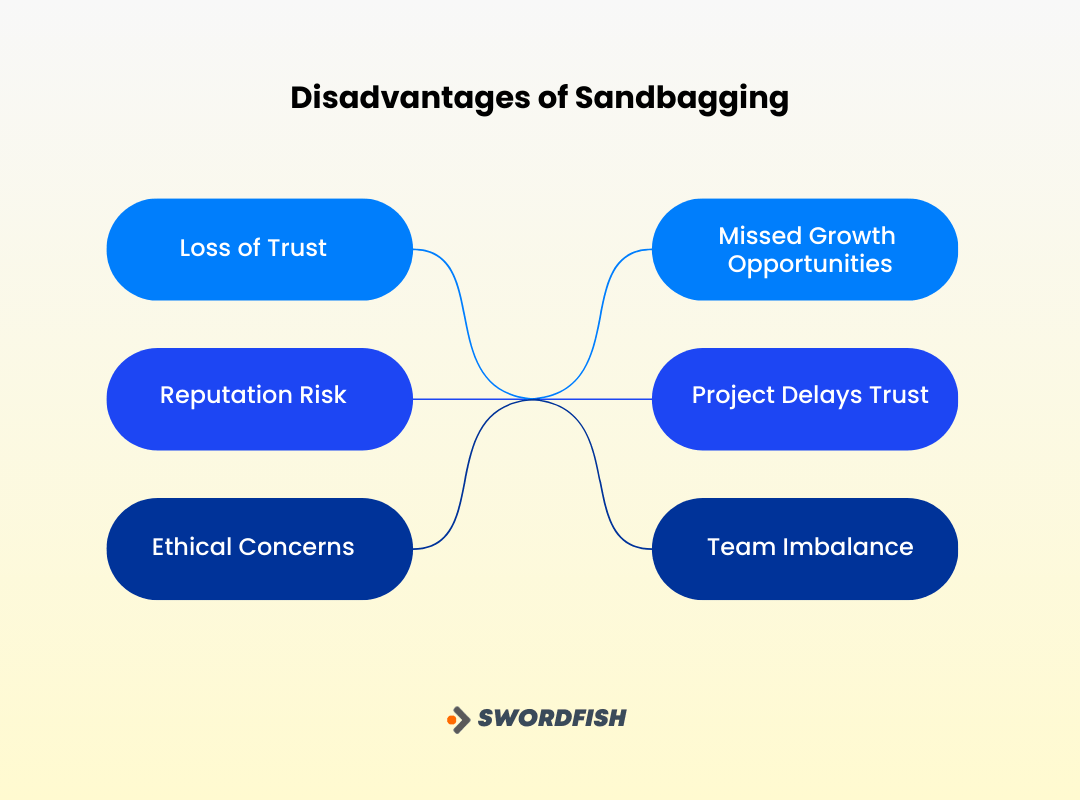
Sandbagging, while it might seem advantageous, often leads to more problems than benefits in a work setting. Here are some key drawbacks —
- Loss of Trust: When you deceive others about your capabilities, it damages trust and creates a dishonest work culture. Be careful, as 71% of people in a PwC study said they would buy less from a business if they lost trust in it.
- Missed Growth Opportunities: By underselling your abilities, you might overlook chances for professional development and growth.
- Reputation Risk: Sandbagging can harm your professional image. Once trust and credibility are lost, they’re hard to regain.
- Project Delays: Misrepresenting your abilities can lead to poor allocation of resources, affecting project outcomes.
- Ethical Concerns: Misleading others intentionally goes against many organizations’ values and ethical standards.
- Team Imbalance: Lying about skills or contributions can create workload imbalances, reduce efficiency, and slow down project progress.
So, while sandbagging might offer short-term gains, its long-term impact is often detrimental to individual and team success. To counter the disadvantages of sandbagging, such as missed growth opportunities, you can benefit from a comprehensive lead generation guide.
What are Examples of Sandbagging?
Sandbagging, a strategy used in various situations, is especially common in the workplace. Here’s how it plays out —
Sandbagging in a Startup
In a startup, leaders might hide their true growth potential to surprise investors with better results than expected. This can impress shareholders and attract more investment, especially important for a new company in a competitive market.
By consistently doing better than their own forecasts, the startup gains trust and keeps shareholders happy, expecting their shares to grow in value. However, this strategy has risks.
If the company always outperforms its predictions, investors will expect more over time. This makes it hard and expensive to keep up, and eventually, people might realize what’s happening, which could damage the company’s reputation.
Sandbagging in Investing and Asset Purchases
Sandbagging involves setting low expectations about a company’s or individual’s abilities to gain an advantage. In business, it’s common for company leaders to project lower results than they can actually achieve.
This tactic is also seen in sports and games, like poker, where players might bluff to increase their chances of winning. The risk of sandbagging too much in business is that it can harm investor trust, analyst opinion, and even stock prices.
During asset or business sales, sandbagging happens when the seller doesn’t fully disclose important information about what’s being sold. It can lead to the buyer discovering mistakes or missing details in the seller’s claims and using them to seek compensation after the deal is done.
Beware of clauses in the sale agreement that allow the buyer to claim compensation even if the seller knows of these issues. A seller can avoid this by researching the buyer’s acquisition history and reviewing the initial sale agreement carefully.
Sandbagging in Sales
In sales departments, the sandbagging term is often used by staff aiming to hit their targets. Since most sales teams earn through commissions, they might set lower goals to easily surpass them, boosting their commissions and bonuses.
For instance, if a salesperson has a monthly quota, they might aim lower to make it easier to exceed. Additionally, they might save extra sales for slower months. While this strategy can lead to extra bonuses, it also limits the salesperson’s potential.
With lower targets, they ensure consistently high results without added management pressure. For example, a salesperson might claim they can increase sales by 10% next quarter, even though they’re capable of a 15% increase.
Conclusion
What does sandbagging mean in business? We’ve explored what it means and why it happens, let’s connect the dots. We defined sandbagging as purposely lowballing targets and forecasts due to perfectionism or fear of under-delivering. Potential upsides include guaranteed wins; downsides weaken trust.
So, use our insights to find out if sandbagging exists in your culture via anonymous polls and open discussions. It can reveal hidden tensions that impact goals and communication.
Rebuilding an atmosphere of aspirational integrity around targets starts with identifying root psychological drivers. With this knowledge, you can leadpositive shifts toward transparency and intentionality.
Frequently Asked Questions
Are sandbagging and bluffing the same thing?
Sandbagging is more common in finance, while bluffing is often seen in games and leisure activities. Both involve deceiving others about one’s abilities or intentions, only to later reveal a different outcome than expected.
What is the opposite of sandbagging in business?
In business, the opposite of sandbagging is ‘blue-skying.’ It’s when salespeople let their optimism influence their judgment, leading to overly positive assessments of potential sales or business opportunities.
Is sandbagging illegal?
Sandbagging isn’t illegal. Businesses sometimes use it to boost investor confidence, like with angel investors or shareholders. However, relying on it too much can backfire, eroding the trust and reputation a company has built.
Over time, if a business can’t meet these inflated expectations due to a lack of skills or commitment, it can face serious setbacks.


 View Products
View Products 















